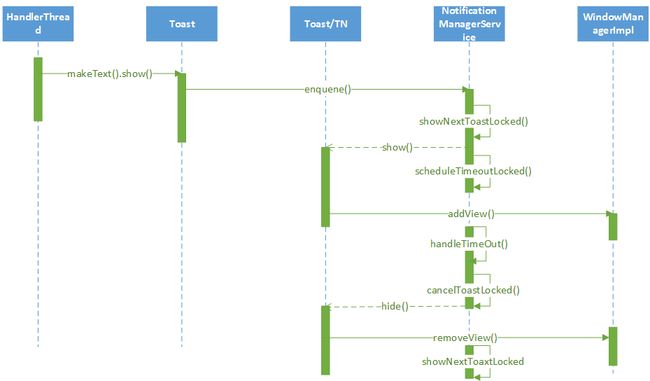前言
上次看到有人说Toast属于UI操作,只能在主线程中使用。其实不是这样的,Toast是特殊的UI操作,由系统管理,我们只需在线程中创建MessageQueue和Looper让Toast能够回调当前线程即可在任意线程使用,主线程由于属于ActivityThread,默认创建了消息队列,所以可以直接使用Toast,Thread中则需要:
Looper.prepare();
Toast.makeText(context,text,duration).show();
Looper.loop();
注意:
- 文中大量涉及到进程间通讯机制Binder的使用,建议先看些Binder的资料
- 文中源码过长的有省略,想要阅读源码的朋友可以在这两个网站上查看:1、http://androidxref.com 2、 http://www.grepcode.com/
下面结合源码详细介绍一下Toast的显示之路,为了方便理解,先展示UML图:
总结
因为每个Toast显示时间可能冲突,因此需要一个管理者来统一管理他们,在一个队列中一个一个显示,所以要使用管理者(NMS)的binder引用将Toast入队,显示又要调用使用线程的binder引用,因此Toast的显示大量用到了进程间通信。
- 在使用线程中调用Toast.makeText(),创建一个Toast实例
- 调用toast.show();在这个方法中又调用getService()获取NotificationManagerService的binder引用,将toast和mTN(继承自ITransientNotification.Stub的TN类的实例,用来提供给NMS一个Binder引用,需要显示Toast时可以调用TN的方法)等信息enqueue(),插入NMS中的待显示序列。
- 轮到某个Toast显示时,在NMS中调用TN类的show()方法,在show方法中又通过handler在使用线程中直接获取WindowManagerImpl然后addView,将Toast添加在Window中。
- 显示的同时NMS也发送了一个延时消息,显示时间过后就会调用TN的hide()方法,通过handler在使用线程中调用WindowManagerImpl的removeVIew()方法删除该Toast
源码分析
Toast的创建
创建Toast我们都会,最简单的方法就是 makeText();
看一下源码:
public static Toast makeText(Context context, CharSequence text, @Duration int duration) {
//创建一个Toast
Toast result = new Toast(context);
LayoutInflater inflate = (LayoutInflater)
context.getSystemService(Context.LAYOUT_INFLATER_SERVICE);
View v = inflate.inflate(com.android.internal.R.layout.transient_notification, null);
//Toast中要显示的TextView
TextView tv = (TextView)v.findViewById(com.android.internal.R.id.message);
tv.setText(text);
result.mNextView = v;
//Toast显示的时间
result.mDuration = duration;
return result;
}
重要语句已注释,现在我们知道在调用makeText时返回值就是创建完毕的Toast。下面看show()方法。
加入NMS的Toast队列
系统中有可能很多程序都想要显示Toast,如果同时出现就失去了原有的作用,因此必须有一个管理者来统一管理所有需要显示的Toast,这个管理者就是系统服务之一:NotificationManagerService
public void show() {
if (mNextView == null) {
throw new RuntimeException("setView must have been called");
}
//获取NotificationManagerService的客户端
INotificationManager service = getService();
String pkg = mContext.getOpPackageName();
//tn是系统将会调用的回调,来真正实现将Toast显示在当前Window
TN tn = mTN;
tn.mNextView = mNextView;
try {
service.enqueueToast(pkg, tn, mDuration);
} catch (RemoteException e) {
// Empty
}
}
看到这里,我们发现了两个重要的类,INotificationManager和TN。
INotificationManager:(AIDL声明的接口,具体实现在INotificationManager.Stub里,而系统服务NotificationManagerService正式继承了INOtificationManager.Stub)是系统服务NMS在本地的binder引用,也就是客户端,我们要跨进程调用NMS的方法就要用到它。获取方法:
static private INotificationManager getService() {
if (sService != null) {
return sService;
}
sService = INotificationManager.Stub.asInterface(ServiceManager.getService("notification"));
return sService;
}
TN:是真正实现将Toast显示到当前Window的工具,它继承自ITransientNotification.Stub,也就是一个服务端,NMS可以调用TN的binder引用来调用TN的show()和hide()方法来显示隐藏Toast。
通过调用NotificationManagerService的enqueue()方法,很明显是要把包名,回调、显示时间发送过去统一排队,一个一个显示。下面看看排队时发生了什么
NMS回调TN
排队时发生了什么呢,贴上源码:重要的就是这个同步的部分,前面省略
synchronized (mToastQueue) {
//这里获取请求线程的pid和Uid
int callingPid = Binder.getCallingPid();
long callingId = Binder.clearCallingIdentity();
try {
ToastRecord record;
int index = indexOfToastLocked(pkg, callback);
// If it's already in the queue, we update it in place, we don't
// move it to the end of the queue.
//英文注释很清楚了,这个index表示这条Toast是不是已经存在在队列中且尚未显示,如果是,则刷新。
if (index >= 0) {
record = mToastQueue.get(index);
record.update(duration);
} else {
// Limit the number of toasts that any given package except the android
// package can enqueue. Prevents DOS attacks and deals with leaks.
if (!isSystemToast) {
int count = 0;
final int N = mToastQueue.size();
for (int i=0; i= MAX_PACKAGE_NOTIFICATIONS) {
Slog.e(TAG, "Package has already posted " + count
+ " toasts. Not showing more. Package=" + pkg);
return;
}
}
}
}
record = new ToastRecord(callingPid, pkg, callback, duration);
mToastQueue.add(record);
index = mToastQueue.size() - 1;
keepProcessAliveLocked(callingPid);
}
// If it's at index 0, it's the current toast. It doesn't matter if it's
// new or just been updated. Call back and tell it to show itself.
// If the callback fails, this will remove it from the list, so don't
// assume that it's valid after this.
if (index == 0) {
showNextToastLocked();
}
} finally {
Binder.restoreCallingIdentity(callingId);
}
}
这其中的内容主要就是判断一下Toast在index中位置是不是0,如果是,就显示,不是,就刷新自己。下面还要看看showNextToastLocked();
private void showNextToastLocked() {
ToastRecord record = mToastQueue.get(0);
while (record != null) {
if (DBG) Slog.d(TAG, "Show pkg=" + record.pkg + " callback=" + record.callback);
try {
//正主终于来了,当年存入ToastRecord的回调终于派上用场,这里调用的,就是TN的show方法。
record.callback.show();
//计算好时间,显示既定时间之后就删除,这个函数一会儿再说。
scheduleTimeoutLocked(record);
return;
} catch (RemoteException e) {
Slog.w(TAG, "Object died trying to show notification " + record.callback
+ " in package " + record.pkg);
// remove it from the list and let the process die
int index = mToastQueue.indexOf(record);
if (index >= 0) {
mToastQueue.remove(index);
}
keepProcessAliveLocked(record.pid);
if (mToastQueue.size() > 0) {
record = mToastQueue.get(0);
} else {
record = null;
}
}
}
}
刚才终于通过binder引用回调了TN的show方法,那么我们回过头去看:
TN调用WMS显示Toast
代码很长,但是总结一下其实就是在请求线程中执行handleShow()方法,利用WindowManager的addView()方法,在Window中添加toast。
@Override
public void show() {
if (localLOGV) Log.v(TAG, "SHOW: " + this);
mHandler.post(mShow);
}
final Runnable mShow = new Runnable() {
@Override
public void run() {
handleShow();
}
};
public void handleShow() {
if (localLOGV) Log.v(TAG, "HANDLE SHOW: " + this + " mView=" + mView
+ " mNextView=" + mNextView);
if (mView != mNextView) {
// remove the old view if necessary
handleHide();
mView = mNextView;
Context context = mView.getContext().getApplicationContext();
String packageName = mView.getContext().getOpPackageName();
if (context == null) {
context = mView.getContext();
}
mWM = (WindowManager)context.getSystemService(Context.WINDOW_SERVICE);
// We can resolve the Gravity here by using the Locale for getting
// the layout direction
final Configuration config = mView.getContext().getResources().getConfiguration();
final int gravity = Gravity.getAbsoluteGravity(mGravity, config.getLayoutDirection());
mParams.gravity = gravity;
if ((gravity & Gravity.HORIZONTAL_GRAVITY_MASK) == Gravity.FILL_HORIZONTAL) {
mParams.horizontalWeight = 1.0f;
}
if ((gravity & Gravity.VERTICAL_GRAVITY_MASK) == Gravity.FILL_VERTICAL) {
mParams.verticalWeight = 1.0f;
}
mParams.x = mX;
mParams.y = mY;
mParams.verticalMargin = mVerticalMargin;
mParams.horizontalMargin = mHorizontalMargin;
mParams.packageName = packageName;
if (mView.getParent() != null) {
if (localLOGV) Log.v(TAG, "REMOVE! " + mView + " in " + this);
mWM.removeView(mView);
}
if (localLOGV) Log.v(TAG, "ADD! " + mView + " in " + this);
mWM.addView(mView, mParams);
trySendAccessibilityEvent();
}
}
NMS回调TN
在NMS中又是怎么计时的呢,还记得刚才在回调TN的show()方法之后调用的方法吗?scheduleTimeoutLocked();
private void scheduleTimeoutLocked(ToastRecord r)
{
mHandler.removeCallbacksAndMessages(r);
Message m = Message.obtain(mHandler, MESSAGE_TIMEOUT, r);
long delay = r.duration == Toast.LENGTH_LONG ? LONG_DELAY : SHORT_DELAY;
mHandler.sendMessageDelayed(m, delay);
}
很简单的一个函数,取需要显示的时间delay,然后发送一个延迟delay时间的消息,并且将ToastRecorder对象传递过去,这个消息是干嘛呢,继续往下看:
private final class WorkerHandler extends Handler
{
@Override
public void handleMessage(Message msg)
{
switch (msg.what)
{
case MESSAGE_TIMEOUT:
handleTimeout((ToastRecord)msg.obj);
break;
}
}
}
收到消息后,执行handleTimeOut方法,并且将该ToastRecorder对象传递过去:
private void handleTimeout(ToastRecord record)
{
if (DBG) Slog.d(TAG, "Timeout pkg=" + record.pkg + " callback=" + record.callback);
synchronized (mToastQueue) {
int index = indexOfToastLocked(record.pkg, record.callback);
if (index >= 0) {
cancelToastLocked(index);
}
}
}
直接看最后一句,cancelToastLocked,在一个Toast显示的时候其他Toast不能显示,现在肯定是先取消这个锁,继续看:
private void cancelToastLocked(int index) {
ToastRecord record = mToastQueue.get(index);
try {
//在这里调用了TN的hide()方法
record.callback.hide();
} catch (RemoteException e) {
Slog.w(TAG, "Object died trying to hide notification " + record.callback
+ " in package " + record.pkg);
// don't worry about this, we're about to remove it from
// the list anyway
}
mToastQueue.remove(index);
keepProcessAliveLocked(record.pid);
if (mToastQueue.size() > 0) {
// Show the next one. If the callback fails, this will remove
// it from the list, so don't assume that the list hasn't changed
// after this point.
showNextToastLocked();
}
}
在这个函数里面,首先是调用TN的hide()方法,隐藏显示完毕的Toast,然后判断还有没有需要显示的Toast,如果有的话,继续显示下一条。
TN调用WMS删除Toast
到这里已经差不多了,TN的hide被客户端调用,发生的情况和show()差不多,也是在请求线程中通过WindowManager,remove掉刚才添加的Toast。
@Override
public void hide() {
if (localLOGV) Log.v(TAG, "HIDE: " + this);
mHandler.post(mHide);
}
final Runnable mHide = new Runnable() {
@Override
public void run() {
handleHide();
// Don't do this in handleHide() because it is also invoked by handleShow()
mNextView = null;
}
};
public void handleHide() {
if (localLOGV) Log.v(TAG, "HANDLE HIDE: " + this + " mView=" + mView);
if (mView != null) {
// note: checking parent() just to make sure the view has
// been added... i have seen cases where we get here when
// the view isn't yet added, so let's try not to crash.
if (mView.getParent() != null) {
if (localLOGV) Log.v(TAG, "REMOVE! " + mView + " in " + this);
mWM.removeView(mView);
}
mView = null;
}
}
